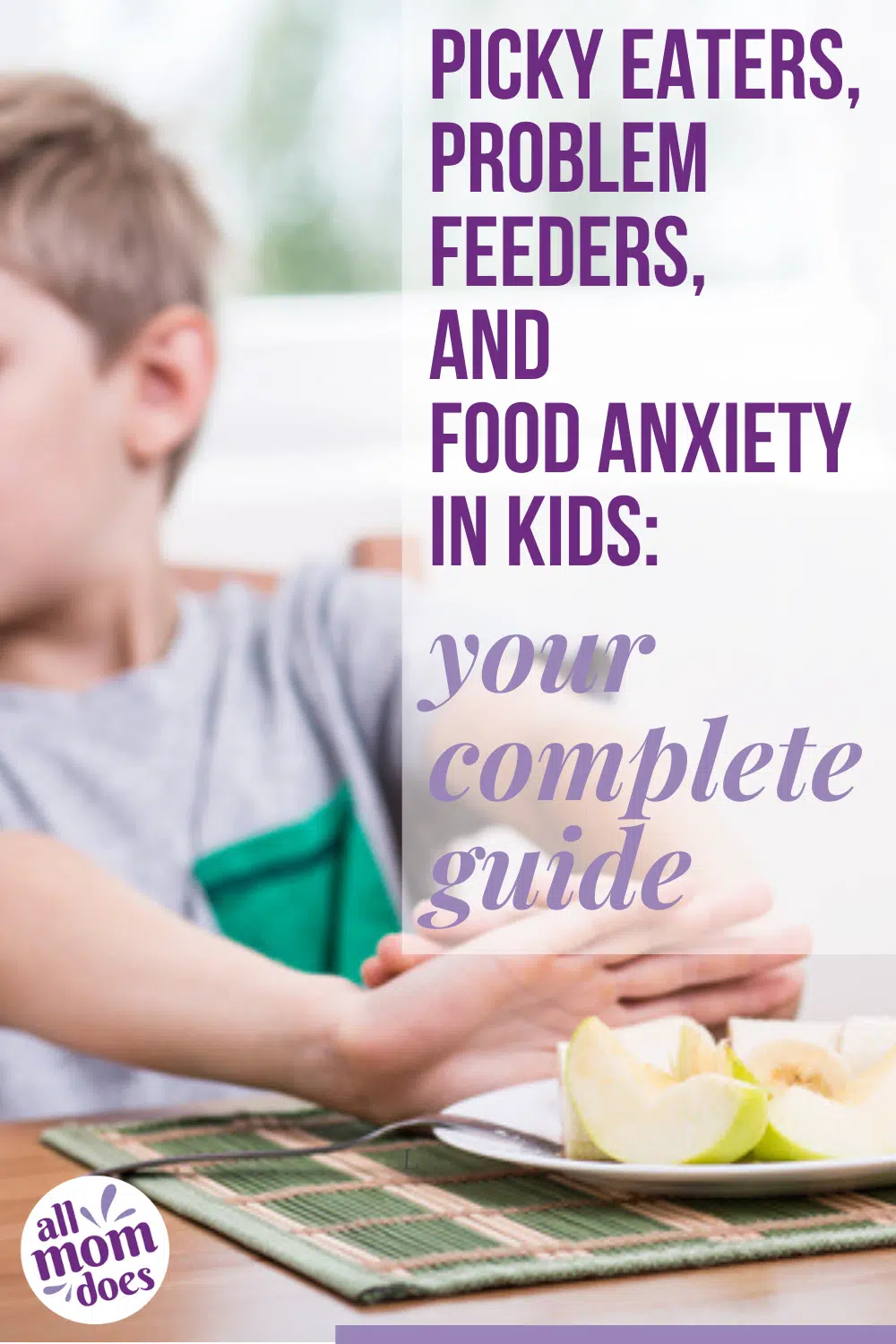Everyone has opinions when it comes to children, food, and so-called “picky eaters.” The problem is rife with parental worries about development and nutrition, societal expectations of perceived health and conformity, and a child’s need for autonomy. And the solution is just as complex; there is plenty of disagreement in the medical community on the proper approach to address feeding issues in children.
And even in cases where the solution is straightforward, the implementation is never easy.
If you’re struggling with feeding in your house, you’re not alone. Up to 50% of parents with toddlers say theirs is a picky eater. A study of kids ages 2-6 found that 20% were truly classified as picky eaters, and the good news is that most kids grow out of it eventually.
When Does Picky Eating Start?
In the most classic cases, pickiness tends to begin around age 2 and wane around age 6. It’s probably no coincidence that this is also the time when kids are developing their independence and begin to show strong preferences for other things: specific types of clothing, toys, or their favorite blue cup. This is normal development and it should be expected.
But Don’t I Need to Worry About My Picky Eater’s Health?
Most parents’ response to picky eating is born from a place of concern for their child’s health. They worry about malnutrition, compromised health caused by a lack of certain micronutrients, or weight – whether under-weight due to eating refusal or overweight due to a preference for “unhealthy” foods. Thankfully, the research indicates that there is no discernable difference in the growth patterns of picky vs. non-picky eaters, and that even though parents perceived they may be deficient in certain nutrients, their food intake often exceeded the recommended amounts of specific nutrients so their nutritional needs were still being met.
What Causes Picky Eating?
There is no universally-accepted scientific study that identifies why some kids become picky and others don’t. While some may be influenced by maternal eating habits and parental control at mealtimes, others just become selective for no discernable reason at all. As a parent, take comfort in the fact that picky eating isn’t caused by your failure to offer enough varied options as your child began solid foods, because you didn’t breastfeed, or didn’t opt for baby-led weaning. For every story about a mom whose children always ate everything they put in front of them, there is a mom whose child gobbled up crazy international dishes for their first year but then subsisted on nothing but bread and rice when they decided to refuse everything in toddlerhood.
If your child has developmental delays, you can expect that picky eating will be a challenge you’ll encounter on your parenting journey. As many as 80% of children with special needs experience struggles with mealtime – whether due to neurological issues, physical challenges, or other concerns.
Is It Picky Eating or Something Else?
“Picky eating” is a blanket term parents use to describe kids who don’t eat as wide a variety of foods as they think they should. It’s not a medical diagnosis, and there is no medical standard as to what constitutes a picky eater vs. a non-picky eater. The perception varies widely by family, too. A picky eater in one family might refuse to eat meat but love salad, while another picky eater might protest any veggie on his plate and live on processed carbs alone.
That being said, there are actual medical conditions that can affect your child’s feeding patters that may present as picky eating. So before you can tackle your child’s feeding issues, you need to know exactly what you’re dealing with. Do you have a bona fide picky eater, a problem feeder, or does your child have some sort of food anxiety?
1. PICKY EATERS
This is exactly what you think it is – kids who refuse a wide variety of foods. Picky eaters:
- Are not refusing foods because of allergies, sensory issues, or medical conditions
- Are simply refusing food because they don’t like (or don’t think they like) anything but their “normal” foods
- Are demonstrating their control and autonomy; they may refuse to try new things because as a child, they have so little control over the rest of their environment that their food is one area where they can exercise independence
- May occasionally go on “food jags” where they insist on one specific type of food, prepared a certain way, at every meal – but they eventually burn out on it and will go back to their regular rotation
- A “typical” picky eater has 30 or more foods that they will accept. If their diet becomes more limited than that, they become classified as “extremely picky” and the approach to solving their dietary issues becomes more complex.
For “typical” picky eaters, the solution is fairly straightforward and involves creating structure around mealtimes (see Ellyn Satter’s Division of Responsibility below) and not offering alternate food options from the meal that’s been served. I said it was straightforward – but I didn’t say it was easy.
2. PROBLEM FEEDERS
Problem feeders are complex group of kids that have feeding issues not solved with the straightforward “typical picky eater” approach. Problem feeders:
- May have sensory issues that make it impossible to eat certain textures or flavors without gagging or throwing up
- May insist that a parent feed them or else they won’t eat
- May cry or panic at the prospect of trying a new food
- Have 20 or fewer foods in their repertoire
- If they “burn out” on a certain food after a food jag, they still refuse it a couple weeks later – they never regain that food on their “accepted” list
- They almost always eat a meal separate from the rest of the family at meal times
- Generally, their list of acceptable foods grows shorter rather than longer over time
Extreme picky eating can devolve into Avoidant Restrictive Food Intake Disorder (ARFID), which is marked by significant nutritional deficiency, reliance on oral nutritional supplements (such as nutrition shakes), and failure to achieve typical growth patterns. Problem feeders typically need professional support from occupational therapists or pediatric dieticians to overcome their feeding challenges.
3. FOOD-ANXIOUS KIDS
Within problem feeders is another category of kids that develop anxiety about food. Anxious eaters:
- May be afraid to try new things because they have allergies and are terrified of a reaction (even if they’re assured it’s a safe food)
- May fear choking, or be anxious about how it will make their stomach or body feel
- May simply be anxious about trying something new because they’ve been a “picky eater” for so long that it’s outside their comfort zone (food neophobia)
- May have engaged in so many mealtime battles with adults that eating itself has become anxiety-inducing
- Older children may develop anxiety about their food restrictions if it affects their social life or limits their ability to do “normal” things like go to parties and attend sleepovers
It often takes support from mental health professionals to help kids overcome anxiety-related disordered eating.
How Do I Help My Picky Eater?
Picky eating is not solved quickly. It’s a long-term commitment to helping your child diversify their food options. If you have a “typical” picky eater, the process is pretty straightforward and can usually be accomplished without the help of medical intervention. However, if they transition into an extremely picky eater, if their feeding issues are caused by underlying medical, neurological, or psychological problems, or if they develop anxiety related to disordered eating, you will need to enlist the help of a team of medical professionals.
Here are some strategies to help you tackle picky eating in your home:
1. RULE OUT MEDICAL PROBLEMS
If you suspect your child’s eating problems are exacerbated by a physical issue, make sure they have a full medical workup to rule out or identify any potential causes. Dentists can recognize abnormalities in the mouth that may cause issues with chewing or swallowing. If your child is in speech therapy, talk to the therapist. If your child is anxious that foods might give them a stomachache, have them tested for food allergies and sensitivities. A severely anemic child may lack energy and enthusiasm for food, and a malnourished child may feel nauseated and lack interest in eating.
2. DIVIDE RESPONSIBILITIES
Ellyn Satter revolutionized the world of childhood nutrition with her development of the Division of Responsibility model. This takes the battle out of mealtime by dividing mealtime responsibilities between the child and the parents so the child is responsible for feeding themselves and meeting their body’s needs. The parent decides WHAT, WHEN, and WHERE the child will eat by offering a variety of foods at set meal and snack times, and the child decides WHETHER and HOW MUCH they’re going to eat when that time rolls around. This provides parental leadership and structure around mealtimes and snacks, while the child gets complete autonomy to function within that structure.
The kicker is that parents need to respect the child’s autonomy; if they opt to not eat anything, or seven helpings of one dish at dinnertime and no veggies, there are no negative comments, no bribing, no pleading. A simple comment of, “I want you to think about your body; is there enough food in it to last until snack time in two hours?” is okay, but negative comments (or skeptical looks and eye-rolling) are not.
Respect your child’s autonomy, and if you stick to your responsibilities and provide meals and snacks at regular times, they’ll begin to respect the structure and learn how to feed their bodies in the way that it needs.
3. GET ON THE SAME PAGE
If you are in a two-parent household, both parents must be on the same page. No strategy will work if parents are sabotaging each other. If one parent feels that any declaration of hunger is an emergent need that needs to be addressed immediately while the other insists that slight hunger is simply a body’s indication that it’s getting ready for the next meal or that regular snacking throws off the body’s normal hunger cues and innate regulation, you’re going to have a problem. Talk about these things before implementing any strategy.
4. TAKE A NEUTRAL STANCE:
Don’t label foods as “good” or “bad.” Don’t let your concern about your child’s health spill over into your interactions with them about food. Whenever engaging with your child about food, make it neutral. Repeated neutral exposure is how kids try new foods (not repeated exposure where you bribed them with dessert if they took a bite of their broccoli). Offer food, respect their autonomy, and offer it again another time. Don’t stop offering it after one refusal or taste. Kids may need to see a food 12-30 times before they accept it. Turning mealtimes into a pressure-cooker of expectations may cause kids to develop guilt or anxiety around food.
5. TALK ABOUT FOOD IN NON-EATING SITUATIONS
Kids do need to be informed about food and its effects on their body, but the dinner table is not the time to do that. Doing so changes the eating environment from neutral to emotionally charged, and can put pressure on your child. Talk about food during non-eating times, but focus on the benefits of choosing certain foods (rather than demonizing things like sugar or processed foods). Educate them on the ways food interacts with their body so they can begin to make the best choices for themselves, but make sure your tone is emotionally neutral. You are sharing information with your child – not persuading or putting pressure on them.
Say things like, “Eating more fruits and vegetables can help make your poop softer so you don’t get constipated,” or, “Mommy gets really tired and grumpy when she skips lunch because my body needs food to work well!” You can even address the myth that your kids have to like everything they eat. Sometimes we choose certain foods because they are good for us or make our bodies feel a certain (positive) way; “liking” doesn’t necessarily have to be a prerequisite for eating.
6. MAKE MEALTIME ABOUT CONNECTION
Part of the structure you provide for meals acts as a conduit for connection with your child. As mentioned before, it’s not a battle for control. Whether your child chooses to eat or not, make food-centric times about conversation and connection and insist that they come to the table. When setting aside time to eat, do it at a dedicated space away from other activities. This also helps provide structure for kids whose disordered eating is caused by inattention to their body’s needs (for example, kids with ADHD who may forget they’re supposed to be eating if you allow them to multi-task and read a book or watch a show while eating). Your job is to make the eating time enjoyable, whether they choose to enjoy the actual food or not.
7. ADDRESS YOUR OWN FOOD ISSUES
Kids pick up on things, whether you say them out loud or not. If you have an unhealthy relationship with food or don’t love your body, your kids will notice. If you’re secretly worried about your kids becoming over/underweight or malnourished, they’ll tune in to your anxiousness. In one study, it was determined that most kids with extreme food pickiness had parents with anxiety. No matter how hard we try to do the “right” thing, our kids are intuitive. They’ll pick up on our discomfort and it will affect their own relationship with food. The only solution is to tackle our own food and/or body issues head-on so we can help our kids develop their own healthy approach to food.
8. INTUITIVE EATING: Intuitive eating has grown in popularity in recent years to combat unhealthy diet culture and encourage people to tune in to their body’s foods needs. Individuals following IE eat what they want, when they want, depending on hunger cues and satiety. While seemingly simple, it’s complex in that to do it properly people need to change the way they view food and their bodies.
Intuitive eating has primarily been an adult-oriented movement, but has so radically changed how people view our food culture that naturally they want to raise kids to be intuitive eaters. Because, when kids are born – they are. They cry when they feel hunger and stop sucking their bottles when they feel satiated. They leave half their piece of cake on their plate and run off to play because they’re full. As parents, we train them out of this intuitive nature when we put expectations on them at mealtimes by insisting they take “five more bites,” clean their plate, or take a “no thank you” bite of everything. They’re also trained out of it by societal forces, marketing, and externally-driven motivation (like eating as a solution for boredom rather than hunger) that comes into play around 4 or 5 years old.
Intuitive eating is a trust relationship with your child that they know their body and can recognize its needs; however this doesn’t mean that it’s a free-for-all with unlimited access to the snack cabinet. As parents, if we ascribe to intuitive eating for our kids, we need to help guide our kids in recognizing their body’s needs while still providing structure around food. Most IE professionals recommend following Ellyn Satter’s Division of Responsibility (see above) when following the model for kids to provide structure around food intake and to train them to be attentive to their bodies and fuel them as necessary at set meal and snack times. They get consistent, regular access to food (at structured meal and snack times), during which you can coach them to listen to their bodies about what they need when it’s time to eat.
And yes, sometimes we choose food for emotional reasons and that’s OK; they just need to learn how to recognize and be aware of that (without feeling shame around it). Because, let’s be honest – sometimes we do need that bowl of ice cream.
Check out this podcast series for more detailed information on raising intuitive eaters.
9. ENLIST A TEAM OF PROFESSIONALS
If your child’s pickiness continues to worsen, or you try to expand their palates to no avail, enlist the help of professionals in the field. There are Occupational Therapists who specialize in sensory-related food aversions, Pediatric Dieticians to help with eating strategies, Speech & Language Pathologists to assist with chewing and swallowing issues, and Psychologists or Psychiatrists to help with managing anxiety or exposure therapy.
If you ever have concerns about your child’s eating habits, talk to your doctor. If you’re not satisfied with their response, seek out a Pediatric Dietician. Eating is a biological need, and while the standard advice of “They’ll eat if they get hungry enough” is true for the vast majority of neurotypical kids, it’s not true for all kids. Help is possible for picky eaters but you need to know exactly what you’re dealing with first, have a clear plan on how to tackle it, and stick to it until it works. The road to recovery may be long, but it will be worth it. And take comfort in the fact that you’re not the first one to travel it – and that you’re definitely not alone.

RELATED:












